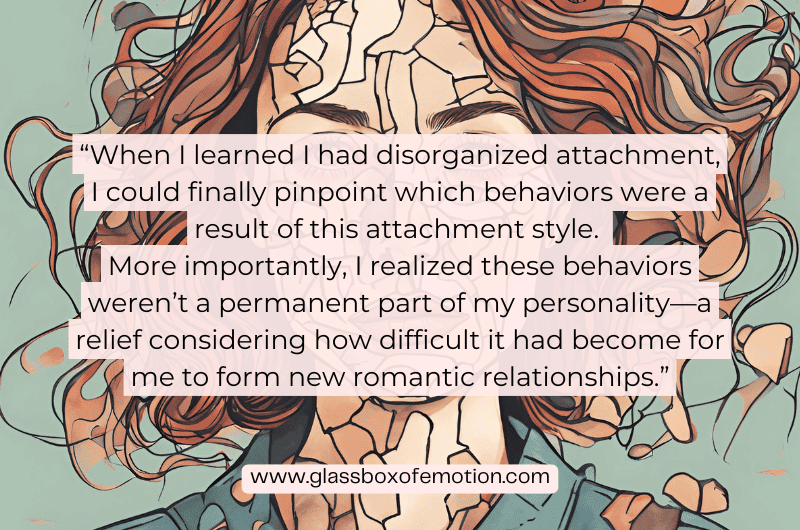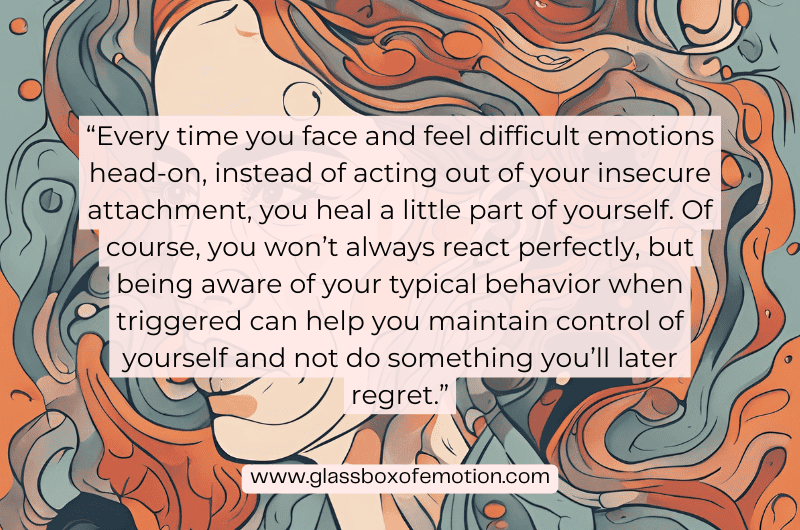A disorganized attachment style is a difficult type of insecure attachment.
According to Mariana Bockarova, PhD, people who get attached in a disorganized way oscillate between two biological drives:
- the need to belong (to love and connect), and
- the need to survive (to protect themselves)
In romantic relationships, people with this attachment style are intensely afraid and anxious. They also suffer from negative self-image and self-talk.
Having lived with this attachment style for most of my life, I know firsthand how overwhelming it can be.
It takes you on a roller coaster of emotions, pulling you between wanting a secure, loving relationship and fearing it. And it hurts your self-esteem.
Because it damages your self-worth, you might be prone to dating emotionally unavailable or even abusive people. Which reconfirms your belief that relationships are unsafe.
Recovering from this style of attachment seems like a Herculean task.
You might have no clue where to begin.
Luckily, I’ve been doing the work for the past couple of years and have a good idea of what’s effective.
So today, I’ll share how I’m healing my disorganized attachment.
While I’m not a therapist, my first-hand experience has shown me that with the right tools, anyone can make positive progress and loosen the grip of this insecure attachment style.
1. Understanding How Disorganized Attachment Impacts Me

Awareness was the first step I made when healing my disorganized attachment style.
Although it sounds like generic advice, you can’t begin to heal something if you’re unaware of how it impacts you specifically.
In 2020, I first learned about the two most common insecure attachment styles—anxious and avoidant. But for obvious reasons I didn’t know at the time, I didn’t feel like I fit into either category.
I knew that I exhibited both anxious and avoidant behaviors, but I didn’t realize there was another attachment style—disorganized or fearful-avoidant—that I actually had.
So I put attachment styles on the back burner and focused on understanding my issues through the lens of complex PTSD.
It wasn’t until late 2022, while reading a book that outlined different attachment styles, that I first encountered a description of disorganized attachment.
Every sentence resonated deeply, and I finally understood why I struggled to trust people yet desperately wanted to be close to them. The realization was liberating.
I could finally pinpoint which behaviors were caused by this attachment style.
More importantly, I understood these behaviors weren’t a permanent part of my personality—a relief considering how difficult it had become for me to form new romantic relationships.
2. Therapy Is a Key Step
When I discovered I had disorganized attachment, I was already in therapy, working on issues that were essentially manifestations of my attachment style.
Therapy became the next crucial step in my healing. I know some people have had bad experiences with therapists, but I was fortunate to find a professional who understood my needs.
She supported me not just with Gestalt therapy but also with somatic exercises. And this loosened the grip of the childhood experiences that had led to my attachment style.
This is key to overcoming disorganized attachment, which is rooted in early childhood events that damage your connection and trust with your primary caregivers.
Working through these experiences in a safe environment with a therapist can help you dig out the roots of disorganized attachment and rebuild trust in others.
3. Confronting My Fears
Disorganized attachment is also known as fearful-avoidant attachment, so it comes as no shock that fear is a huge component of it.
Because fear marked our early childhoods, we believe the world is a bad place filled with even worse people. Which makes us afraid of being hurt again, especially in a close relationship.
Sadly, people with disorganized attachment often end up in relationships with manipulative, emotionally unavailable, or even abusive partners. And this confirms the story in our minds that forming new relationships leads to pain.
If this happens to you one too many times, you might become afraid of meeting new people – not to mention going on dates.
But the only way to overcome this fear is to face it.
In the beginning, I found it very difficult to restart dating after a prolonged period of being single. (Due to a previous toxic relationship.)
My first instinct was to run at the first sign of a potential red flag. I would psych myself out before meeting someone new, imagining all the ways they could harm me.
But I kept reminding myself that I’m an adult now, capable of protecting myself. And that I have developed strong boundaries that will prevent me repeating the same toxic relationship.
Over time, every person I met and every positive experience I had chipped away at the fear until it was a manageable rock—not a boulder I struggled to carry on my shoulders.
4. Rebuilding My Self-Esteem

Another essential part of healing my disorganized attachment was working on my self-esteem.
Many people with this attachment style struggle with self-confidence–we don’t believe we are loveable or that we deserve to be in a healthy relationship.
While I knew I had some self-esteem issues, therapy opened my eyes to just how deeply these issues ran.
A breakthrough moment in therapy came when I realized I couldn’t imagine myself in a relationship with the kind of person I wanted because I didn’t think I was worthy of them.
So how did I build my confidence back up?
This was a non-linear process. With the help of my therapist, I was able to remind myself that I have value, that I’m loved by the people around me, and that these positive relationships aren’t flukes.
Limiting access to people who made me feel worthless was also crucial.
Why?
Because if you keep dating people who don’t respect you, you’ll believe you aren’t worth much. But surrounding yourself with people who value you (and show it) creates a positive feedback loop, helping you believe in your worth.
Setting boundaries and speaking your mind is another important part of building your self-esteem.
It’s very easy to talk about setting boundaries, but when the person you’re dating does something that crosses them, what will you do?
Will you pretend everything is fine and then later be mad at home? Or will you speak your mind and even break things off if you’re unable to find a solution?
I promise you that the latter option is one that’s going to make you feel more confident in the long term.
5. Healing Through Relationships

The final part of healing disorganized attachment happens in relationships, especially romantic ones.
Certain triggers only surface when you let someone in, fall in love with them, and decide to trust them.
For example, if a new partner forgets to call you back for a few hours, you might become angry or anxious. Navigating these emotions without letting them consume you is key.
Every time you face and feel these emotions head-on, instead of acting out of your insecure attachment, you heal a little part of yourself.
Of course, you won’t always react perfectly, but being aware of your typical behavior when triggered can help you maintain control of yourself and not do something you’ll later regret. (Like getting in a furious argument with your partner and sabotaging your relationship.)
I found it helpful to reach out to friends when I felt triggered and was on the verge of overreacting. Talking to someone who can offer a different perspective will help you see the situation more clearly.
Obviously, you can only heal in a secure and stable relationship. An inconsistent and dismissive partner will only make things worse, so it’s important to know the difference between an overreaction to normal behavior and a normal reaction to a toxic behavior.
Don’t Forget about Patience and Persistence
Finally, be patient with yourself. You’ve likely spent a lifetime with disorganized attachment, and changing these ingrained patterns takes time. They’ve played an important role in protecting you, and it’s difficult for your nervous system to let them go.
Don’t punish yourself when you slip up—it’s normal. Those who had happy, stable childhoods will have a different perception of the world than someone who grew up in a broken home filled with fear.
Just by making an effort to change, you’re teaching your body a new way of responding. Over time, with the support of a stable and understanding partner, you can develop a secure attachment style and rebuild trust in romantic connections.
Thank you for reading! If you enjoyed this article, let me know: you can connect with me on Instagram, Twitter, and Pinterest. All opinions are my own and don’t represent the views of anyone else.
Recent Posts
There’s a certain kind of irony to the phrase “I’m just a girl.” Once used by No Doubt in the ‘90s as a tongue-in-cheek rebellion against sexism, it’s now being recycled online...
Dating apps have completely transformed how Gen Z approaches love and connection. But it hasn’t always made things easier. In fact, using dating apps can feel like its own kind of emotional...

